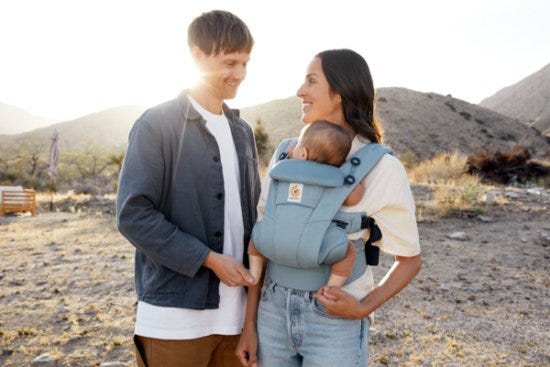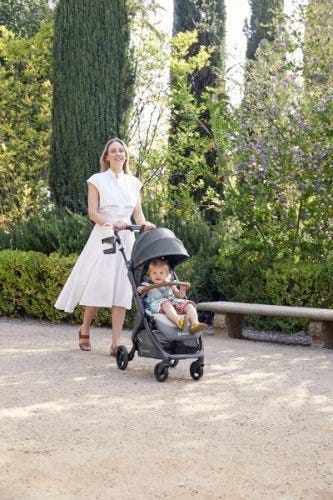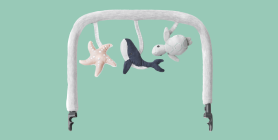
Have you ever wondered about babywearing? It’s a great thing to try! There are so many wonderful benefits of babywearing. From supporting baby’s natural posture to reducing infant crying, strengthening the bond between baby and her caregivers and more, using a baby carrier is a win-win for you and your baby, emotionally, cognitively and physically.
But if you’ve never used a baby carrier, everything is new and unknown. So, you might be asking yourself things like what kind of ergonomic baby carrier should you use? When can you start using a baby carrier? Is a baby carrier safe for newborns? What about baby carrier safety and hip dysplasia?
Here are the basic things you need to know about using a baby carrier.
1. You can start using a baby carrier from day one.
So, let’s start with the question: is a baby carrier safe for newborns? Yes, but it depends on a few factors. Some parents think they can’t use a baby carrier until their baby is six weeks old or older, or they choose to wait until then. But you can actually take a baby carrier with you to the hospital and use it the day your baby is born, as long as they weigh at least seven (7) pounds. This is a great opportunity to bond with your new baby. Babies need to maintain a close connection with mom and dad right from the start. And while you can get that closeness by holding your baby in your arms, it’s not convenient to hold your baby four-plus hours a day. However, you’ll find that using a baby carrier is very easy and convenient. Additionally, it’s a great way to get in the benefits of skin-to-skin contact from the start. Just be sure your baby meets the minimum weight requirement for your baby carrier for safety
2. Do research on different baby carriers.
There are so many types of baby carriers out there. The most popularly-used ones today are wraps, slings, soft-structured (often referred to as "buckle") and Mei Tai baby carriers. Research types and safety reviews online, ask family and friends about baby carriers they use and go check out different types of baby carriers in stores before purchasing one.
 3. Know the different baby carrying positions and when to use them.
3. Know the different baby carrying positions and when to use them.
Did you know there are different ways to hold a baby in a carrier? The main baby-carrying positions include:
- Front inward facing
- Front outward facing
- Hip carry
- Back carry.
Your baby’s weight, age and developmental stage will determine when it’s appropriate to use the different baby carrying positions. So, keep that in mind and check your owner’s manual to be sure you follow its minimum weight and age requirements, but the following is about when you can typically start using the four different carrying positions based on age:
- Front inward facing: 0+ months
- If you’re not sure where to start, getting a carrier, like the Omni Breeze or Omni Dream, is perfect. These baby carriers will work for all little ones, in all carry positions, and don’t need an infant insert. It truly is the All-In-One carrier you’ve been looking for as an on-the-go parent! What's the difference between the two? The fabric! If you're looking for ultimate breathability, Breeze is for you. If soft and cozy sounds like your preference, you'll want to go with the Dream.
- Front outward facing: 4-6+ months (Baby’s neck needs to be strong enough to hold up his head, so this could mean as early as 4 months or not until he’s 6 months old.)
- Hip carry: 6+ months
- So he’s started wanting to constantly get up and get down out of your carrier and you’re a little exhausted from fiddling with a complicated carrier. How do you satisfy his curiosity while keeping him secure in a carrier? That’s simple, hip carrying is the perfect solution. It let’s you have the convenience of letting your baby explore and stay curious, while keeping him perfectly safe!
- Back carry: 6+ months
- Your little one has started to move around more while you carry him around and is more curious about what’s going on around him in the world, that’s great! Having a carrier that will grow with your baby and his needs is essential, which is why a 360 Baby Carrier (like Omni Breeze, Dream, or 360) is a great solution for your little one and your wallet!
4. Know how to practice safe babywearing.
Nothing matters more to you than making sure your baby is loved and protected. You want to keep your baby safe while in her baby carrier, and you want to feel safe and comfortable while using the baby carrier. Here are the do’s and don’ts of baby carrier safety:
-
Carry your baby in the correct position.
This means keeping him sitting upright with his neck fully supported, airways open, chin off his chest, as well as close against you and higher up on your torso. You should be able to bend down and kiss his sweet, little head.
-
Sit baby in an ergonomic position.
Your baby should be sitting in a natural wide-leg, spread-squat position with her knees higher than her bum, think an M or frog leg shape. This ergonomic carrier position supports your baby’s spine, hips and legs to help prevent hip dysplasia.
-
Secure all carrier fasteners.
Make sure any buckles, snaps, wraps, etc., are securely fastened or locked to keep baby safe and secure inside the carrier.
-
Check fabric for wear and tear.
Fabric tears and holes could make the baby carrier unsafe to use.
-
Be more cautious and alert.
Because your center of gravity changes when you wear your baby, your chances of falling can increase. Be more aware of your surroundings and careful when on or nearby stairs, slippery surfaces, curbs and other tripping hazards.
-
Don’t overdress.
Being so close against you, it can be easy for your baby to overheat inside his baby carrier. Be mindful of the season, outside and inside temperatures (depending on where you’ll be), what you’re wearing and what you’ll be doing so you can appropriately dress your baby.
-
Don’t lie down while using a baby carrier.
Babies need to stay in an upright position in their baby carrier, so if you need to lie down, take your baby out of her carrier first.
-
Don’t bend at your waist.
If you need to bend down, bend at your knees so your baby stays in an upright position.
-
Don’t use a baby carrier while biking, running, skiing, snowboarding, etc.

Light physical activity like walking, hiking and even babywearing yoga are fine, but intense physical activity should be avoided while using your baby carrier because it’s unsafe for your baby and can be for you, too.
-
Don’t drink hot liquids or eat hot foods.
Getting cookie crumbs on your baby’s head is no big deal, but you’d never want to accidentally spill hot coffee or soup on your baby’s sensitive head. Be mindful of what you drink and eat while babywearing.
5. Practice using the baby carrier before putting your baby in it.
Once you have your baby carrier, don’t immediately start babywearing your newborn. You first need to learn how to babywear and get used to your carrier. Here are the steps to follow:
- Start by reading your owner’s manual and watch a few instructional videos.
- Try practicing taking it on and off, adjusting it and testing out the different positions. Use a baby doll or teddy bear if you want.
- Even once you feel comfortable, having a spotter nearby lending a helping hand the first time you use your baby carrier with your baby and keep one hand supporting your baby.
- Practice, practice, practice until you feel comfortable. You got this!
Using a baby carrier has a lot of great benefits for both you and your baby, from promoting physical and emotional well-being to offering a hands-free solution for busy parents. If you’re looking for a new baby carrier, make sure to take a look at Ergobaby. Our carriers have all been carefully designed to fit different needs and preferences. So, you can find a carrier that works the best for you and your little one.
Emotional Benefits of Getting Outside
Spending time in nature with your baby can strengthen the bond between you. The simple act of holding your baby close, feeling their warmth, and sharing new experiences together can create strong emotional connections. It’s also a wonderful way to reduce stress and improve your mood. When my littles were extra fussy, I’d take a walk around the neighborhood. Even though I don't live in an area with trails and surrounded by nature, simply behind outside changed everything. A little vitamin D does wonders!
Cognitive Development
Nature is a sensory wonderland for babies. The different sights, sounds, and smells can stimulate your baby’s senses and promote cognitive development. Watching leaves rustle, hearing birds chirp, and feeling the texture of a tree bark can all contribute to their learning and development.
All About Baby Carriers for Nature Adventures
Choosing the Right Baby Carrier
When it comes to selecting the best baby carrier for summer adventures, there are several options to consider.
Types of Baby Carriers:
- Wraps: Perfect for newborns, providing a snug and secure fit.
- Slings: Ideal for quick and easy use, offering good ventilation.
- Soft Structured Carriers: Versatile and comfortable for both parent and baby, suitable for longer trips.
Factors to Consider:
- Baby’s Age and Weight: Ensure the carrier is appropriate for your baby’s size and weight. For example, Ergobaby’s Embrace Newborn Carrier is perfect for the fourth trimester where baby is small and you’re looking for an easy way to stay close. As they grow, you’ll want to upgrade to an all-position carrier that’s meant for growing babies.
- Parent’s Comfort and Ergonomics: Look for carriers with padded shoulder straps and lumbar support if you’re planning on longer outings.
- Ease of Use: Choose a carrier that is easy to put on and take off.
- Climate and Breathability: Opt for carriers made of breathable fabrics to keep you and your baby cool in hot weather.
Safety Tips:
- Proper Positioning: Ensure your baby is seated correctly, with their legs in an "M" position and their head should be close enough to kiss.
- Checking for Wear and Tear: Regularly inspect your carrier for any signs of damage.
- Ensuring Adequate Support: Make sure the carrier provides proper support for your baby’s head and neck.
Exploring Nature with a Baby Carrier
Ideal Spots for a Nature Walk with Baby
- Parks and Gardens: Great for leisurely walks and picnics.
- Nature Trails and Forests: Perfect for more adventurous outings.
- Beaches and Lakesides: Wonderful for enjoying the water and sand, with the right carrier.
Activity Ideas
- Hiking: Enjoy a scenic hike with a hiking baby carrier that offers support and storage.
- Bird Watching: Use your carrier to keep your baby close while you explore and observe wildlife.
- Picnics: A carrier can free up your hands, making it easier to carry picnic supplies.


Advantages of Using Strollers for Nature Adventures


While baby carriers are fantastic for mobility and closeness, depending on the adventure of choice you might want to be a stroller along too.
There are a LOT of baby stroller options on the market. So we understand how confusing it can be to choose the one that’s right for your family. Not only are there a variety of brands, but a variety of strollers that serve different purposes.
There are a few types of strollers on the market:
- Full-sized stroller: This is typically the stroller parents thing of buying for all its versatility.
- Lightweight or umbrella stroller:These compact strollers are perfect for on-the-go adventures.
- Jogging stroller: Designed for parents who want to combine fitness with outdoor adventures.
- Double stroller: Designed for parents with multiple kids, especially twins.
- Car seat carrier: These strollers connect to a specific car seat. We don't typically recommend these as they can be unsafe for baby and uncomfortable for parents who are pushing.
Learn more about the types of strollers and which one would be best for you.
Benefits of Bringing a Stroller
- Storage Space for Gear: Ample room for carrying all your essentials like a diaper bag, beach toys and more.
- Shade and Weather Protection: Built-in canopies to shield your baby from the sun when they are lounging.
- Options: If you have more than one kid, you can stroll with one and carry the other. Or, if you’re getting warm or your little one is getting fussy, you can switch up their position from stroller to carrier or vice versa.
Safety Tips for Strollers
- Ensure your stroller is in good working condition. Make sure buckles are still buckling and that there are no rips or holes that could compromise your baby’s safety.
- Use sunshades or bug nets to protect your little one’s skin.
- Securing the baby properly: always buckle up your baby for safety even if you think they are old enough to go without the buckle.
Combining Baby Carriers and Strollers
For the ultimate flexibility, consider using both a baby carrier and a stroller on your outings.
Combining both options allows you to adapt to different situations. Use the carrier for more rugged trails and switch to the stroller for smoother paths or when your baby needs a nap.
Transition Tips
- Smooth Transitions: Plan stops where you can easily switch from carrier to stroller.
- Pack Light: Only bring essentials to make transitions easier.
Tips for a Successful Adventure
Planning Ahead
- Route Planning: Choose baby-friendly trails and parks. Check local mom groups or outdoor groups and get recommendations for the best outings for kids.
- Check Weather Conditions: Avoid extreme heat or unpredictable weather. Even with our most breathable carriers, when it’s hot, it’s hot. And having two bodies against each other in the heat will be naturally hot and sticky already.
- Packing Checklist: Include diapers, snacks, water, sunscreen, and a first-aid kit. These all-position carriers have storage pockets where you can fit some of the items easily!
- Stay Hydrated and Nourished: Pack healthy snacks to keep energy levels up and bring plenty of water for both you and baby.


Summer adventures with your baby are a wonderful way to create lasting memories and enjoy the beauty of nature together. From baby carriers to strollers, Ergobaby products are designed to provide comfort and ease for both you and your little one. So, gear up, get outside, and explore the world with your baby by your side.
Ready to embark on your own summer adventures? Check out Ergobaby’s range of baby carriers and strollers to find the perfect match for your family’s needs. Visit our website today and start planning your next outdoor excursion!



























